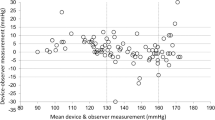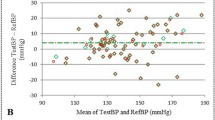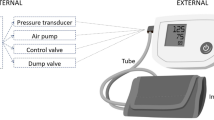Abstract
Accurate blood pressure (BP) measurement is important for the detection and treatment of hypertension. Despite widespread use of automated devices, there is limited published evidence for their reliability and accuracy. To determine the reliability and accuracy of the Dinamap 1846XT (Critikon Corporation, Tampa, FL, USA), a commonly used non-invasive oscillometric BP monitor The Dinamap was evaluated against the mercury manometer in 70 randomly selected adult hospitalised medical patients. Each individual underwent three sets of standardised BP measurement by automated method and three sets by mercury manometer by two independent observers. Reliability of BP measurement was assessed by repeated measures analysis. Dinamap accuracy was evaluated according to the American Association of Medical Instrumentation (AAMI) and British Hypertension Society (BHS) guidelines. Most patients were either normotensive or had stage I hypertension. The Dinamap tended to overestimate lower diastolic BP, and displayed poor reliability (P < 0.05). despite meeting aami guidelines, only 59% of systolic and 56% of diastolic dinamap readings were within 5 mm hg of the mercury manometer and 84% of systolic and 80% of diastolic readings were within 10 mm hg (bhs grade c). systolic and diastolic accuracy were worse with pressures >160/90 mm Hg (grade D) although these measures were based on a smaller sample of subjects. In conclusion the Dinamap yields inaccurate estimates of both systolic and diastolic BP even under standardised, and thus optimal conditions. This inaccuracy is exaggerated at higher BP (>160/90 mm Hg), although the number of measurements at higher pressures was small. We recommend that this device not be used when accurate BP measurement is needed for therapeutic decision-making.
This is a preview of subscription content, access via your institution
Access options
Subscribe to this journal
Receive 12 digital issues and online access to articles
$119.00 per year
only $9.92 per issue
Buy this article
- Purchase on Springer Link
- Instant access to full article PDF
Prices may be subject to local taxes which are calculated during checkout


Similar content being viewed by others
References
Neaton JD, Wentworth D MRFIT Research Group. Serum cholesterol, blood pressure, cigarette smoking, and death from coronary heart disease. Overall findings and differences by age for 316,099 white men Arch Intern Med 1992 152: 56–64
Brophy JM . The epidemiology of acute myocardial infarction and ischemic heart disease in Canada: data from 1976 to 1991 Can J Cardiol 1997 13: 474–478
Grundy SM et al. Guide to Primary Prevention of Cardiovascular Diseases. A statement for healtheare professionals from the Task Force on Risk Reduction Circulation 1997 95: 2329–2331
Hansson L . The benefits of lowering elevated blood pressure: a critical review of studies of cardiovascular morbidity and mortality in hypertension J Hypertens 1996 14: 537–544
Hansson L et al. Effects of intensive blood pressure lowering and low-dose aspirin inpatients with hypertension: principal results of the Hypertension Optimal Treatment (HOT) randomized trial Lancet 1998 351: 1755–1762
Wonka F . Oscillometric blood pressure measurement: description of the method used Z Kardiol 1996 85 (S3): 1–7
White WB et al. National standard for measurement of resting and ambulatory blood pressures with automated sphygmomanometers Hypertension 1993 21: 504–509
AAMI. American National Standard for Electronic or Automated Sphygmomanometers Arlington, VA, Association for the Advancement of Medical Instrumentation 1987
O'Brien E, Mee F, Atkins N, O'Malley K . Short Report: accuracy of the Dinamap portable monitor, model 8100 determined by the British Hypertension Society protocol J Hypertens 1993 11: 761–763
Wattigney WA, Webber LS, Lawrence MD, Berenson GS . Utility of an automatic instrument for blood pressure measurement in children. The Bogalusa Heart Study Am J Hypertens 1996 9: 256–262
Shuler CL et al. Accuracy of an automated blood pressure device in stable inpatients: optimum vs routine use Arch Intern Med 1998 158: 714–721
Sun M, Tien J, Jones R, Ward R . A new approach to reproducibility assessment: clinical evaluation of SpaceLabs Medical oscillometric blood pressure monitor Biomed Instrum Technol 1996 30: 439–448
Ling J et al. Clinical evaluation of the oscillometric blood pressure monitor in adults and children based on the 1992 AAMI SP-10 standards J Clin Monit 1995 11: 123–130
Fitzgeralds D et al. Accuracy and reliability of the Del Mar Avionics pressurometer III J Hypertens Suppl 1985 S3: S359–S361
O'Brien E et al. The British Hypertension Society protocol for the evaluation of automated and semi-automated blood pressure measuring devices with special reference to ambulatory systems J Hypertens 1990 8: 607–619
O'Brien E et al. An outline of the revised British Hypertension Society protocol for the evaluation of blood pressure measuring devices J Hypertens 1993 11: 677–679
Grim CM, Grim CE . A curriculum for the training and certification of blood pressure measurement for health care providers Can J Cardiol 1995 11 (Suppl H): 38H–42H
Haynes RB et al. Report of the Canadian Hypertension Society Consensus Conference: 2. Diagnosis of hypertension in adults Can Med Assoc J 1993 149: 409–418
Curb JD et al. Training and certification of blood pressure observers Hypertension 1983 5: 610–614
Bland JM, Altman DG . Statistical methods for assessing agreement between two methods of clinical measurement Lancet 1986 1: 307–310
Stolt M, Sjonell G, Astrom H, Hansson L . Factors affecting the validity of the standard blood pressure cuff Clin Physiol 1993 13: 611–620
Author information
Authors and Affiliations
Corresponding author
Rights and permissions
About this article
Cite this article
Beaubien, E., Card, C., Card, S. et al. Accuracy of the Dinamap 1846 XT automated blood pressure monitor. J Hum Hypertens 16, 647–652 (2002). https://doi.org/10.1038/sj.jhh.1001463
Received:
Revised:
Accepted:
Published:
Issue Date:
DOI: https://doi.org/10.1038/sj.jhh.1001463
Keywords
This article is cited by
-
Race/ethnicity determines the relationships between oxidative stress markers and blood pressure in individuals with high cardiovascular disease risk
Journal of Human Hypertension (2017)
-
Bramwell-Hill modeling for local aortic pulse wave velocity estimation: a validation study with velocity-encoded cardiovascular magnetic resonance and invasive pressure assessment
Journal of Cardiovascular Magnetic Resonance (2012)
-
Reductions in resting blood pressure after 4 weeks of isometric exercise training
European Journal of Applied Physiology (2010)
-
Cardiovascular haemodynamic response to repeated mental stress in normotensive subjects at genetic risk of hypertension: evidence of enhanced reactivity, blunted adaptation, and delayed recovery
Journal of Human Hypertension (2003)



